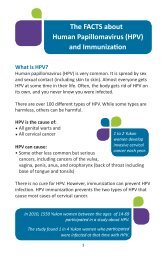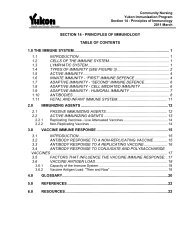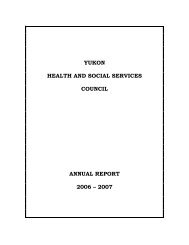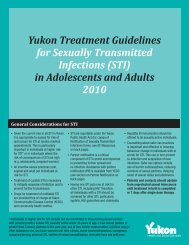Yukon Rabies Risk Management - Guidelines - Health and Social ...
Yukon Rabies Risk Management - Guidelines - Health and Social ...
Yukon Rabies Risk Management - Guidelines - Health and Social ...
Create successful ePaper yourself
Turn your PDF publications into a flip-book with our unique Google optimized e-Paper software.
Airborne transmission has been reported in two instances in a laboratory setting, where there was signifi cant<br />
aerosolization <strong>and</strong> possible lack of personal protection. Also, there have been two reports of rabies acquired in<br />
a bat-infested cave attributed to aerosol transmission, but there is no proof in either case that a bite or wound<br />
contamination did not occur (Irons 1957, Humphrey 1960 as cited in BCCDC, 2011). No well-documented natural<br />
transmission of rabies by aerosols has occurred (Gibbons 2001 as cited in BCCDC, 2011).<br />
Susceptible animals<br />
<strong>Rabies</strong> virus can cause acute encephalitis in all warm-blooded hosts, including pets, livestock, wildlife <strong>and</strong> humans,<br />
<strong>and</strong> the outcome is almost always fatal. Although all species of mammals are susceptible to rabies virus infection,<br />
only a few species are important as reservoirs for the disease, with bats <strong>and</strong> foxes being the most probable<br />
reservoirs in northern climates (Alaska <strong>Rabies</strong> Prevention <strong>and</strong> Control Manual Oct. 2009). Skunks <strong>and</strong> raccoons are<br />
important vectors where they occur but they do not range through <strong>Yukon</strong> currently.<br />
Background of rabies in Canada <strong>and</strong> Alaska<br />
The following information is selective <strong>and</strong> based only on human contact <strong>and</strong> does not rule out rabies in a given<br />
animal species, since all mammals are potentially susceptible to rabies. The information may be used to assess the<br />
risks <strong>and</strong> benefi ts of treatment, particularly when the animal is not available for testing or observation.<br />
Canada<br />
<strong>Rabies</strong> is a fatal disease of mammals most often transmitted through the bite of a rabid animal. Monoclonal<br />
antibodies have revealed that there are distinct variants or strains of rabies virus. Some rabies variants occur within<br />
terrestrial wildlife reservoirs in geographically discrete regions. Virus transmission is primarily between members<br />
of the same species but there are exceptions. Outbreaks of arctic fox rabies have involved arctic foxes (Alopex<br />
lagopus), red foxes (Vulpes vulpes) <strong>and</strong> striped skunks (Mephitis mephitis) as active vectors (MacInnes, 1999).<br />
Other rabies variants are found in many bat species without geographic boundaries. Several bat variants occur in<br />
a single bat species, <strong>and</strong> the geographical distribution of variants is overlapping. Spillover to terrestrial animals is<br />
observed frequently (WHO 2005, as cited in Canadian <strong>Rabies</strong> <strong>Management</strong> Plan, 2009).<br />
Although rabies virus can infect many animal species, each strain is perpetuated within populations of a certain<br />
species that acts as a viral reservoir (Nadin-Davis et. al., 2006, as cited in Canadian <strong>Rabies</strong> <strong>Management</strong> Plan,<br />
2009). In Canada, rabies persists throughout most arctic regions with the arctic fox serving as the main host for this<br />
rabies virus variant. The arctic variant of the rabies virus has been present in the red fox populations in Ontario. Bat<br />
rabies is found throughout Canada. In Canada, the big brown bat is the most commonly diagnosed species; other<br />
bats species include the little brown bat, the silver-haired bat, the hoary bat <strong>and</strong> the red bat (Nadin-Davis et. al,.<br />
2001, as cited in Canadian <strong>Rabies</strong> <strong>Management</strong> Plan, 2009).<br />
<strong>Yukon</strong><br />
At the time of writing this guideline, there have been no reports of human rabies in <strong>Yukon</strong>. From 1955 to 2004 there<br />
have been 88 animal specimens submitted for laboratory testing. In the 1970s, there were four dog, one cat <strong>and</strong><br />
one fox head submissions which tested positive for rabies. There have been 11 animal submissions from the <strong>Yukon</strong><br />
between 1999 <strong>and</strong> 2010, including a bat, bear, cat, lynx, wolf <strong>and</strong> fox as well as four dogs <strong>and</strong> one unspecifi ed<br />
species that all tested negative.<br />
2<br />
GENERAL INFORMATION | October 2011




![Women and Alcohol: A women's health resource [2326.26 KB ]](https://img.yumpu.com/22340649/1/190x245/women-and-alcohol-a-womens-health-resource-232626-kb-.jpg?quality=85)












